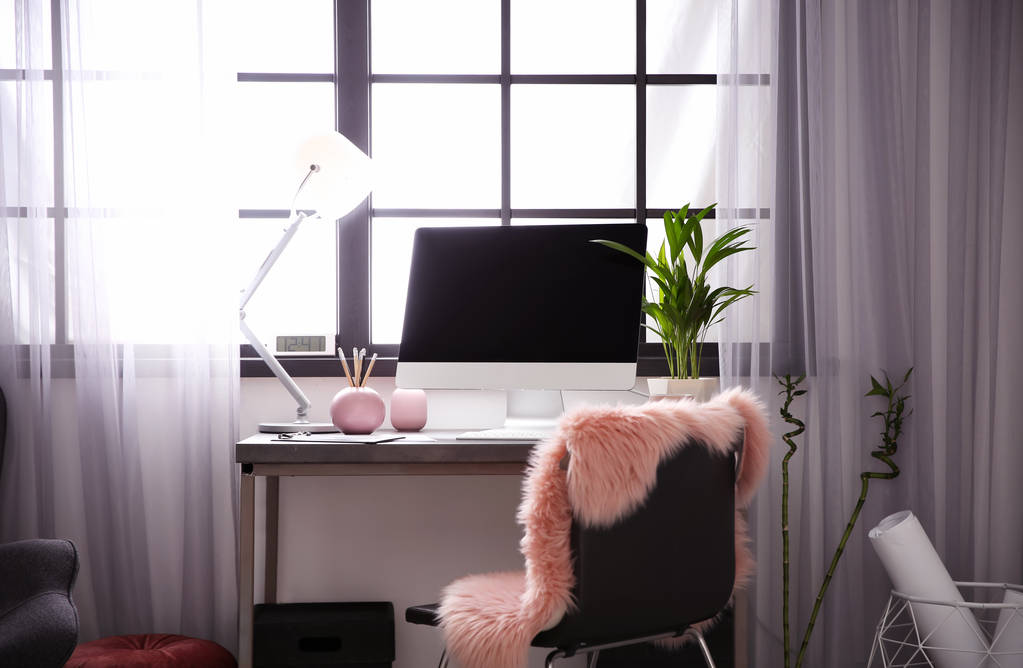Essential furniture pieces for a productive home office
Setting up a productive home office requires more than just a computer and a desk. Furnishing home office with the right furniture pieces can make a significant difference in your comfort, focus, and productivity. Let’s dive a little deeper into the essential furniture pieces for a productive home office.
Desk:
As mentioned earlier, your desk is the centrepiece of your home office. It’s where you spend most of your time, and it needs to be functional and comfortable. When choosing a desk, consider the size, material, and design that will best suit your needs. A larger desk can provide more space to work and help you spread out your work items. You may also want to consider a desk with built-in storage to keep your supplies and paperwork organised. Additionally, if you have a desktop computer, make sure the desk has enough space to accommodate it comfortably. You may also want to consider a standing desk, which allows you to switch between sitting and standing throughout the day.
Office Chair:
Your office chair is another critical piece of furniture for your home office. A good office chair should provide proper support for your back, neck, and arms. Look for a chair with adjustable features, such as height, lumbar support, and armrests. The chair should also be comfortable for long hours of sitting and made with breathable materials to prevent sweating. Additionally, consider the type of flooring you have in your home office. If you have carpet or laminate flooring, look for a chair with wheels that can move smoothly across the surface. If you have hardwood or tile flooring, consider a chair with rubberised castors that won’t scratch the floor.
Bookshelf or Filing Cabinet:
A bookshelf or filing cabinet is an essential piece of furniture to keep your office organised. You can store your documents, files, and office supplies in an easily accessible location. Consider the size of the shelf or cabinet and how much storage space you need before making a purchase. If you have a lot of files, consider a lateral filing cabinet, which can store files horizontally instead of vertically. This type of cabinet can also double as a surface for a printer or scanner.
Lighting:
Proper lighting is important to reduce eye strain and fatigue while working. A desk lamp or overhead lighting can help ensure that you have adequate lighting for your workspace. You may also want to consider natural light sources, such as a window or skylight, to help boost your mood and productivity. If you don’t have access to natural light, consider investing in a light therapy lamp, which can help improve your mood and energy levels.
Storage Units:
In addition to a bookshelf or filing cabinet, consider other storage units, such as drawers, shelves, or cabinets, to help keep your workspace organised and free of clutter. You can store items that you don’t need to access often, such as paperwork, supplies, or equipment, in these storage units. Consider adding a set of drawers or a shelf unit near your desk for easy access to frequently used items.
Rug or Carpet:
A rug or carpet can help reduce noise and create a comfortable and inviting workspace. It can also add a touch of style to your office and help define the space as separate from the rest of your home. Consider a rug with a low pile or a carpet tile system that can be easily replaced if it becomes stained or worn.
Powerboard:
With all the electronics you may need to power, a powerboard can help you stay organised and ensure you have plenty of outlets for all your devices. Choose a powerboard that has enough outlets and surge protection to keep your devices safe. Consider a powerboard with USB ports to charge your phone or tablet, and look for one with a long cord so you can position it where you need it most.
By having the right furniture and workspace, you can create an environment that promotes your productivity and creativity. Remember to also consider the layout of your office, minimise distractions, and establish a routine to help you.


Choosing the right desk for your home work space
Choosing the right desk for your home workspace is critical for your productivity, comfort, and overall well-being. A well-chosen desk will help you stay organised, focused, and comfortable during your work hours, while a poorly chosen one can cause discomfort, distraction, and even physical problems.
To select the right desk for your home workspace, you need to consider several factors, such as your work style, available space, storage needs, material, ergonomics, budget, and user reviews.
Firstly, you need to determine your work style and tasks. Do you work on a computer for most of the time or need a larger desk for writing, drawing, or crafting? Are you someone who likes to have a clutter-free workspace or needs storage for papers, books, or equipment? Based on your answers, you can choose a desk that fits your needs and work style.
Secondly, you need to measure the space where you plan to place the desk. Consider the room size, ceiling height, doorways, and other furniture that might affect the placement and size of the desk. You don’t want to end up with a desk that is too big or too small for your space or blocks the flow of traffic.
Thirdly, you need to think about storage options. Depending on your work style and tasks, you might need a desk with built-in drawers, shelves, or cabinets, or you might prefer separate storage units that you can place under or beside the desk.
Fourthly, you need to consider the material and style of the desk. Desks come in various materials, such as wood, metal, glass, or plastic, each with its advantages and disadvantages. For instance, wood desks are durable and classic but might require more maintenance and be heavier than other materials. Metal desks are sleek and modern but might be more prone to scratches or noise. Glass desks are elegant and easy to clean but might show fingerprints or be fragile. Choose a material that matches your taste, durability, and maintenance preferences.
Fifthly, you need to pay attention to ergonomics. Your desk should be at a comfortable height that allows you to type or write without straining your arms or shoulders. You should also have a supportive chair that allows you to maintain good posture and avoid back or neck pain. Consider investing in a standing desk, a monitor riser, or a footrest if you need to switch positions or alleviate pressure on your feet or legs.
Sixthly, you need to set a budget that reflects your needs and preferences. Desks can range from a few hundred dollars to thousands of dollars, depending on their size, material, features, and brand. You don’t need to overspend on a desk, but you also don’t want to compromise on quality or functionality.
Finally, you should read user reviews or expert reviews to get a better idea of the desk’s performance, durability, ease of assembly, and customer service. Look for reviews that match your needs and priorities and avoid overly positive or negative ones that might be biased.
In summary, choosing the right desk for your home workspace requires careful consideration of your work style, available space, storage needs, material, ergonomics, budget, and user reviews. By taking the time to choose a desk that fits your needs and preferences, you can improve your productivity, comfort, and overall well-being.

